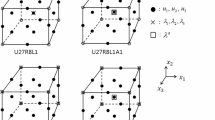Abstract
The following is proved: 1) The linear independence of assumed stress modes is the necessary and sufficient condition for the nonsingular flexibility matrix; 2) The equivalent assumed stress modes lead to the identical hybrid element. The Hilbert stress subspace of the assumed stress modes is established. So, it is easy to derive the equivalent orthogonal normal stress modey by Schmidt's method. Because of the resulting diagonal flexibility matrix, the identical hybrid element is free from the complex matrix inversion so that the hybrid efficiency is improved greatly. The numerical examples show that the method is effective.
Similar content being viewed by others
References
Pian T H H. Derivation of element stiffness matrices[J].AIAA, 1964,2(3): 576–577.
Hoa S V, FENG Wei.Hybrid Finite Element Method for Stress Analysis of Laminated Composites [M]. Boston/Dordrecht/London: Kluwer Academic Publishers, 1998.
HUANG Qian. Modal analysis of deformable bodies with finite degree of deformation freedom-An approach to determination of natural stress modes in hybrid finite elements[A]. In: CHIEN Wei-zang, FU Zi-zhi, Eds.Advances in Applied Mathematics and Mechanics in China[C]. LAP, 1991,3: 283–303.
FENG Wei, Hoa S V, HUANG Qian. Classification of stress modes in assumed stress fields of hybrid finite elements[J].International Journal for Numerical Methods in Engineering, 1997,40 (23): 4313–4339.
WU Chang-chun, Pian T H H.Incompatible Numerical Analysis and Hybrid Finite Element Method [M]. Beijing: Science Press, 1997. (in Chinese)
JIAO Zhao-ping. A method simplifying matrixH of hybrid element[J].Computational Structural Mechanics and Applications, 1991,8(2): 214–216. (in Chinese)
Kardestuncer H.Finite Element Handbook[M]. ZHU De-chao, FU Zi-zhi translate. Beijing: Science Press, 1995. (in Chinese)
Saether Erik, Explicit determination of element stiffness matrix in the hybrid stress method[J].International Journal for Numerical Methods in Engineering, 1995,38(15): 2547–2571.
Han J, Hoa S V. A three-dimensional multilayer composite finite element for stress analysis of composite laminates[J].International Journal for Numerical Methods in Engineering, 1993,36, (22): 3903–3914.
MacNeal R H, Harder R L. A proposed standard set of problems to test finite element accuracy[J].Finite Element in Analysis and Design, 1985,1(1): 3–20.
MacNeal R H. A theorem regarding the locking of tapered four-noded membrane elements [J].International Journal for Numerical Methods in Engineering, 1987,24(9): 1793–1799.
Author information
Authors and Affiliations
Additional information
Contributed by HUANG Qian
Foundation items: the Aid Funds of Ministry of Education to Returnee from Foreign; the Funds of Ministry of Education to Backbone Teachers in Institutions of Higher Education; the Down Program of Shanghai Foundation of Education (99SG38); the Key Project of Shanghai Education Committee
Biography: ZHANG Can-hui (1967-), Doctor
Rights and permissions
About this article
Cite this article
Can-hui, Z., Wei, F. & Qian, H. The stress subspace of hybrid stress element and the diagonalization method for flexibility matrixH . Appl Math Mech 23, 1263–1273 (2002). https://doi.org/10.1007/BF02439457
Received:
Revised:
Issue Date:
DOI: https://doi.org/10.1007/BF02439457




